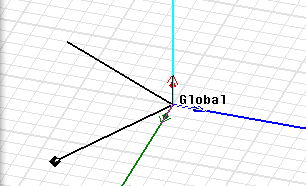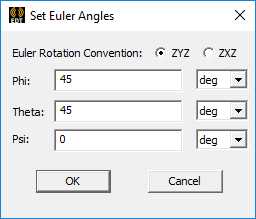Creating a Rotated Relative CS
To create a new relative CS with its axes rotated away from another CS's axes:
- In the History Tree, select the CS upon which you want to base the new relative CS, making it the working CS.
- Click Modeler> Coordinate System> Create> Relative CS> Rotated or, on the Draw ribbon tab, click Relative CS> Rotated:
..png)
- Depending on your Relative Coordinate System Creation Mode choice (Tools> Options> General Options – 3D Modeler> Drawing), or
whether you press F3 or F4, you can specify the axes in one of the following two ways:
- Axis/Position option selected, or F3 pressed – Use one of the following coordinate entry methods:
- Specify the X-axis and XY plane graphically (click to select), as follows:
- Use the cursor to click a point along the desired X-axis. You can see the coordinate information in the Measure Data window.

To select a point that does not lie in the current plane, use the Movement Mode commands or choose a different drawing plane.
- In the same manner, select any point lying on the XY plan that's not on the X-axis.

- Use the cursor to click a point along the desired X-axis. You can see the coordinate information in the Measure Data window.
- Enter the coordinates numerically in the Status Bar, as follows:

- In the Status Bar, choose the type of coordinate system from the rightmost drop-down menu (Cartesian, Cylindrical, or Spherical).
- Select either Relative or Absolute coordinates from the other drop-down menu.
- Type the coordinates of a point on the desired X-axis in the X, Y and Z (or dX, dY, and dZ) text boxes and press Enter.
- In the same manner, type the coordinates of a point lying on the XY plane, but not on the X-axis, and press Enter again.
You do not need to specify the Z-axis. It is automatically calculated to be perpendicular to the new XY plane.
- Specify the X-axis and XY plane graphically (click to select), as follows:
- Euler angle option selected, or F4 pressed:
- In the Set Euler Angles dialog box, select the preferred Euler Rotation Convention (ZYZ or ZXZ).
- Specify the Phi, Theta, and Psi values and select units for each from the drop-down menus.

The new relative CS is created. It has the same origin as the previous working CS, but its axes are rotated. It is listed in the History Tree under Coordinate Systems. It automatically becomes the working CS; objects that you draw hereafter will be based on the coordinates of this relative CS. Default planes are created on its XY, YZ, and XZ planes.

- Axis/Position option selected, or F3 pressed – Use one of the following coordinate entry methods:
